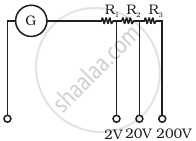Advertisements
Advertisements
प्रश्न
Why does a galvanometer when connected in series with a capacitor show a momentary deflection, when it is being charged or discharged?
How does this observation lead to modifying the Ampere's circuital law?
Hence write the generalised expression of Ampere's law.
उत्तर
During charging and discharging of the capacitor, there is a flow of charge from the battery towards the plates of the capacitor, which produces a conduction current in the circuit. Hence, the galvanometer present in the circuit shows momentary deflection.
As the charge on the capacitor grows, the conduction current in the wires increases. When the capacitor is fully charged, the conduction current stops flowing in the wires. During charging or discharging of the capacitor, there is no conduction current between the plates of capacitor, as they are not connected by any conduction material. Therefore, in this region, a current must exist that makes the total current in the circuit continuous. This observation leads to modifying the Ampere's circuital law.
Thus, there must be displacement current along with the conduction current in the circuit having the property of continuity, although individually they may not be continuous.
Maxwell modified Ampere's circuital law in order to make it logically consistent. He stated Ampere's circuital law in the form,
This is the generalised expression of Ampere's law.
APPEARS IN
संबंधित प्रश्न
A rectangular coil of a moving coil galvanometer contains 50 turns each having area 12 cm2 . It is suspended in radial magnetic field 0.025 Wb/m2 by a fibre of twist constant 15 x10-10 Nm/degree. Calculate the sensitivity of the moving coil galvanometer.
Define current sensitivity of a galvanometer.
A coil of radius 10 cm and resistance 40 Ω has 1000 turns. It is placed with its plane vertical and its axis parallel to the magnetic meridian. The coil is connected to a galvanometer and is rotated about the vertical diameter through an angle of 180°. Find the charge which flows through the galvanometer if the horizontal component of the earth's magnetic field is BH = 3.0 × 10−5 T.
A galvanometer coil has a resistance of 12 Ω and the metre shows full scale deflection for a current of 3 mA. How will you convert the metre into a voltmeter of range 0 to 18 V?
The AC voltage across a resistance can be measured using a ______.
The deflection in a moving coil galvanometer is ______.
In a moving coil galvanometer the deflection (Φ) on the scale by a pointer attached to the spring is ______.
A multirange voltmeter can be constructed by using a galvanometer circuit as shown in figure. We want to construct a voltmeter that can measure 2V, 20V and 200V using a galvanometer of resistance 10Ω and that produces maximum deflection for current of 1 mA. Find R1, R2 and R3 that have to be used.

When a galvanometer is shunted with a 4 Ω resistance, the deflection is reduced to one-fifth. If the galvanometer is further shunted with a 2 Ω wire. The further reduction (find the ratio of decrease in current to the previous current) in the deflection will be (the main current remains the same)
To convert a moving coil galvanometer into an ammeter we need to connect a ______.
